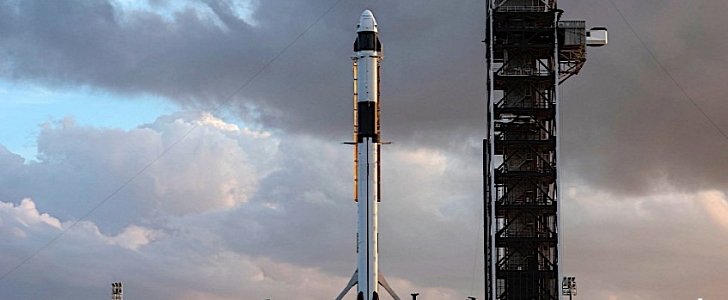Initially scheduled for January 7, the first test flight of SpaceX’s Crew Dragon - a spaceship meant to take humans into space from U.S. soil for the first time in years – is now delayed for January 17, mostly due to the U.S. government’s partial shutdown.
Even if the launch has been delayed, the Crew Dragon rolled onto the Complex 39A launchpad at the Kennedy Space Center in Cape Canaveral, Florida on January 3. A crew access arm has been extended to connect to spacecraft with the tower, making for a sight long-time not seen at the historic launch complex.
Over the weekend, the company’s CEO Elon Musk tweeted a new image of what appears to be the access hatch to the Crew Dragon, adorned on the side with a sign reading “You must be at least this tall to ride.”
This first flight of the Crew Dragon is an uncrewed one, meant to test the capabilities and safety of the capsule’s systems. If all goes well, the spaceship will be cleared for the first crewed flight, which is scheduled to take place in June 2019. In the capsule will sit astronauts Robert Behnken and Douglas Hurley, both members of several Endeavour and Atlantis missions.
When fully operational, the Crew Dragon will be capable of carrying up to seven astronauts seated in carbon fiber seats wrapped in Alcantara cloth. It will conduct transport missions to the International Space Station on top Falcon 9 rockets, but when perched on top the Big Falcon Rocket, it could head for the Moon or even Mars.
According to the limited info available on the capsule, it would eventually be fully autonomous. The Environmental Control and Life Support System (ECLSS) can be controlled by the astronauts, who can set the spacecraft’s interior temperature to between 65 and 80 degrees Fahrenheit.
Should anything go wrong, the emergency escape system would allow astronauts to escape while experiencing about the same G-forces as a ride at Disneyland, according to SpaceX.
Over the weekend, the company’s CEO Elon Musk tweeted a new image of what appears to be the access hatch to the Crew Dragon, adorned on the side with a sign reading “You must be at least this tall to ride.”
This first flight of the Crew Dragon is an uncrewed one, meant to test the capabilities and safety of the capsule’s systems. If all goes well, the spaceship will be cleared for the first crewed flight, which is scheduled to take place in June 2019. In the capsule will sit astronauts Robert Behnken and Douglas Hurley, both members of several Endeavour and Atlantis missions.
When fully operational, the Crew Dragon will be capable of carrying up to seven astronauts seated in carbon fiber seats wrapped in Alcantara cloth. It will conduct transport missions to the International Space Station on top Falcon 9 rockets, but when perched on top the Big Falcon Rocket, it could head for the Moon or even Mars.
According to the limited info available on the capsule, it would eventually be fully autonomous. The Environmental Control and Life Support System (ECLSS) can be controlled by the astronauts, who can set the spacecraft’s interior temperature to between 65 and 80 degrees Fahrenheit.
Should anything go wrong, the emergency escape system would allow astronauts to escape while experiencing about the same G-forces as a ride at Disneyland, according to SpaceX.






